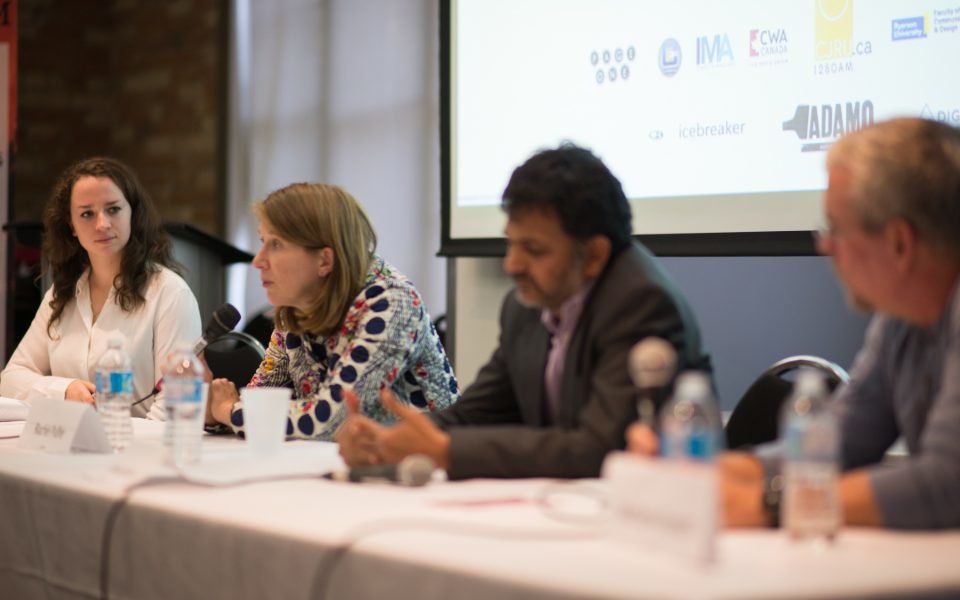
When it comes to covering a disaster, there are dozens of variables journalists must understand and acknowledge before they go to work.
The problem is that during disaster scenarios even the best laid plans can go awry, and an entire story can shift in an instant.
With our fall conference, Covering Disasters: A Critical Lens, the Ryerson Review of Journalism attempted to provide advice for Canadian journalists about how to report, photograph and understand stories related to disaster, drawing on input from some of the industry’s most respected figures.
Here are six takeaways that will help journalists do better the next time they’re called upon to report on an earthquake, a wildfire, a tsunami, or a hurricane—at home or abroad.
1. You’re allowed to have emotions
Reporters are often encouraged to check their feelings at the door when on the job. But New York Times Canada bureau chief Catherine Porter, who reported on the Haitian earthquake for the Toronto Star, says it’s sometimes difficult to balance being a journalist with being a human, which is expected of reporters covering traumatic events.
In Haiti, 1.5-million homes were destroyed, and an estimated 316,000 people were killed, she said. For decades, the nation had been in decline. The population of the capital, Port au Prince, had tripled since the 1980s, but the city’s infrastructure hadn’t expanded accordingly. People were living in poorly structured homes that were highly susceptible to the earthquake’s tremors. “What makes a terrible event like an earthquake a disaster is not nature,” Porter added. “It’s humans.”
“As long as you’re decent and human, that’s the most important thing,” @porterthereport says on dealing with emotions when reporting on disasters #OnDisasters #RRJ
— Karoun Chahinian (@KarounChahinian) November 21, 2017
Porter was given access to hospitals and recovery zones, and once walked into a hospital room to see a woman lying naked on a bare metal table, giving birth.
Porter said part of what journalists must do in these traumatic situations is act as a witness—to share what they see with those who can’t. “But covering disasters is hard on your spirit,” she said. Porter felt guilty to have been in Haiti as a journalist, and “not to help” like the aid workers around her. Eventually, she enrolled a young Haitian girl, Lovely, in school, and was scared she’d crossed the line from journalist to activist.
Many co-workers were angry with her, she said. But soon, they were supportive, and Lovely’s story was revisited several times throughout Porter’s tenure at the Star.
2. Don’t “exotify” the people you’re covering
It isn’t a stretch to say that Columbia Journalism Review chief digital writer Mathew Ingram hates ‘parachute journalism,’ done when reporters with little knowledge of a place fly in to cover a disaster, then leave.
“It is the worst thing that’s ever happened to disaster journalism or in fact foreign reporting of any kind,” Ingram said. “It barely even deserves to be called journalism.”
When reporters arrive, they’re often unaware of cultural differences between their home and the place they’re temporarily staying. Porter credited the depth of her reporting on Haiti to understanding the context in which the earthquake occurred. “Treat victims in foreign places just as we’d treat them in our own,” she added.
Without that context, the reportage suffers, rendering it less impactful. Locals who’ve lived through terrible events are sometimes treated like a foreign entity, and journalists forget they’re real people just like they are.
Ed Ou, of Getty Reportage, said when he’s shooting photos of people in sensitive situations, he tried to spend as much time with them as possible to earn trust and fully comprehend what they’ve been through.
“I see journalism as a function of democracy,” Ou said. If his pictures can help direct attention to a cause, or to encourage government assistance, he feels less as though he’s crossing an ethical boundary by taking pictures of those who’ve been through trauma.
Ryerson School of Image Arts professor Blake Fitzpatrick said it’s important that photojournalists ask themselves whether their work will have a positive impact on those whose images they capture.
“If nothing’s changing for the subject, then that raises ethical questions,” he said.

3. Be prepared to be uncomfortable
CBC’s Marion Warnica recommends bringing a “go bag” at all times. “Basically a mobile desk,” she said. “Everything you’d need to file a story from the side of the road.”
When Warnica covered the Fort McMurray wildfires, that little bag was all she had for an entire week. Before she sent out her staff to cover the fire, Metro Toronto managing editor Angela Mullins said “there honestly wasn’t a lot of prep.”
“Be prepared to live in a car on the side of the road eating bread,” she said. “Be prepared to be uncomfortable.”
How do newsrooms prepare to cover natural disasters? “Basically a mobile desk so you can fold from the side of the road,” says CBC’s Marion Warnica #OnDisasters @RyersonReview
— Amy Van den Berg (@vandenba) November 21, 2017
When disaster strikes, it’s important to bring the essentials. Warnica wore waterproof hiking shoes, while Mullins made sure her employees brought extra batteries for their laptops and devices just in case they needed them. Peter Bregg brought a sleeping bag to cover the aftermath of an earthquake and needed it: for a week, he slept outside.
While journalists must be aware of their own safety, covering disasters puts them into often unstable scenarios. It’s essential to understand that when covering a disaster, journalists are there, like Porter said, to witness what’s happening and to relay that to readers and consumers. It becomes difficult to do that accurately when a journalist is removed from the situation and given preferential treatment.
4. Assess the risks and be open
“Risk assessment should be taken seriously,” said Cliff Lonsdale, the president of the Canadian Journalism Forum on Violence and Trauma.
“It is a professional requirement to think about what you’re doing and try to keep the crew safe. If you can’t keep your crew safe or even get to the scene of the story, what’s the point?” he asked.
Lonsdale said having proper equipment ready, as well as ongoing conversations regarding safety and preparation, are crucial Even if it doesn’t seem financially viable, being prepared can save a newsroom money in the long-run, he added.
Warnica and Mullins said setting up mental health practices to ensure reporters’ well-being is also essential, and Lonsdale believes it to be a shared responsibility between the newsroom and its employees.
“Even if you don’t feel [fatigue or exhaustion] immediately, you’re going to,” Mullins said.
Mullins said speaking to colleagues about emotions is recommended, and leaning on colleagues for support can help prevent long-term effects. She said journalists should seek professional medical advice should they need it, and to be honest with their employers about what they’re going through.
Use mental health supports at your workplace, says @Angela_Mullins. And if you don’t have them, advocate for them. #ondisasters #rrj
— H.G. Watson (@HG_Watson) November 21, 2017
“I think you get much better journalism when you admit you’re human,” Lonsdale said.
5. The story doesn’t stop when you leave
Nothing about a disaster is short-term.
A flood may subside, but the damage it inflicts on infrastructure could last decades. Toxins, metals and carcinogens could still fill the air long after an industrial fire stops burning.
“Everyone seems to have a short attention span after a disaster,” said Saurabh Dani, a World Bank risk assessor. To properly cover a disaster, that needs to change.
“Everyone covers a disaster immediately after,” Ingram added. “Very rarely do you see someone coming in six months or a year later.”
“There are too many reactive stories” and not enough follow-up stories #OnDisasters, says Thurton
— Ryerson RJRC (@RyersonRJRC) November 21, 2017
Dani said as soon as a newsroom begins planning coverage, reporters should indicate their interest in returning to report further. Journalists for Human Rights executive director Rachel Pulfer said newsroom directors will often say they don’t have resources to do that, which is why she, Ingram and Dani agreed funding local journalists was an effective way to extend coverage.
There are people within those countries capable of reporting their own stories, and while foreign bureaus are shuttering, Ingram says people living through the issues are better-suited to reporting their stories.
The voices of people from the places affected are sorely missing from mainstream journalism, Pulfer said. When local people help international reporters, they’re relegated to the title of “fixer,” which doesn’t properly credit the work they do.
Stop calling fixers “fixers,” says saurabh Dani, call them local journalists #OnDisasters @RyersonReview @RSJnow
— Sonya Fatah (@sonyafatah) November 21, 2017
When stories are within your jurisdiction, though, local journalists can stay on the stories and find new angles.
Jayme Poisson of the Star said she has five angles on the go at once, just so she can continue following up in case some take longer to develop. “A good guideline is to deliver stories that push the overall story forward,” she said. Thinking ahead is a key factor in finding the most impactful way to report.
“This is when the people are most vulnerable,” David Thurton of CBC Fort McMurray said, so following through on government accountability and a disaster’s wide-reaching effects are essential.
6. You aren’t a scientist, but try to understand climate change
While natural disasters are usually reported as isolated incidents, Dani said they’re all tied in one way or another to the changing climate. While journalists aren’t scientists, it is their job to relate complex information to readers; climate change shouldn’t be any different.
“Try and do your homework,” Dani said.
“[Disasters] are all exacerbated by the context of climate change,” TVO producer Tim Alamenciak said. “It’s our job to explain it in plain English.”
It’s important to talk to scientists and get them to explain #climatechange change issues when reporting, says Tim Alamenciak – particularly when you’re dealing with cutting-edge science #OnDisasters
— Ryerson RJRC (@RyersonRJRC) November 21, 2017
Journalists may like to consider themselves experts, but they aren’t, and admitting that will improve reporting exponentially. Not many people understand the intricacies of plate tectonics, acid rain or tropical storm systems, and it doesn’t make someone a bad reporter for admitting that.
When a journalist admits they don’t know everything, they learn a lot more than they otherwise would.
Be knowledgeable about science, Alamenciak advised, but know that you are not a scientist.
About the author
Managing Print Editor, Ryerson Review of Journalism